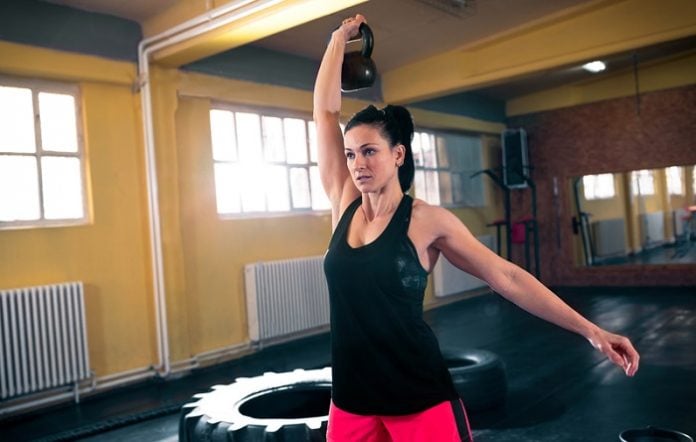
Split Workout Routines
Split workout routines occur when you work out a single muscle group or groups per workout. Some common splits are back/biceps, chest/triceps, and quads.
Split Workout Routines: Why Do Them?
Unless you are solely focused on weight loss and/or cardio, split workouts are definitely something to consider, and here’s why!
When you complete an effective muscle-building workout, your muscles should be sore for 1-3 days.
The soreness usually occurs because the muscle fibers are breaking apart to rebuild stronger.
If you work out a sore muscle, you risk messing with the rebuilding process, which could undo some or all of the progress you made from the previous workout.
In short, it’s best to wait to work out a sore muscle group until it’s not sore anymore.
This is why split workouts can be a bodybuilder’s best friend because they allow for exercise to continue while allowing for sore muscles to fully recover.
The Alarm Reaction
However, there’s another reason muscles can be sore. It’s called the alarm reaction. This often occurs when folks aren’t used to working out a workout for the first couple of times.
It’s essentially the body going, “Oh man, this is something new and different.”
If this happens, have no fear, it’s perfectly normal. However, I would seek some kind of assistance if the soreness lasts more than 3-4 days and/or continues to worsen.
What If My Whole Body Is Sore?
This can happen sometimes-especially for those that are new to fitness or starting a new fitness program.
If your whole body is sore, but you still want to do something active, I suggest taking a restorative yoga class, running without incline, spinning or cycling on low resistance, or walking.
 In short, anything that is light resistance that can provide some sort of cardio is okay to do when the entire body and/or certain muscle groups are sore.
In short, anything that is light resistance that can provide some sort of cardio is okay to do when the entire body and/or certain muscle groups are sore.
Types of Split Workouts
As mentioned previously, there are many different kinds of splits one could do.
You could go less specific such as upper body, core, and lower body.
You could go a little more specific such as front upper body, back Upper body, front of the lower body, back of the lower body.
You could even go further with your splits such as back/biceps, chest/triceps, shoulders, calves/quads, glutes/hamstring, obliques, lower abs, upper abs, etc.
You can really split your workouts up into whatever works best for you, your body, and your goals.
Above are just some examples. Again, it’s paramount to find what’s going to be best for you. Please do not blindly follow my examples without deciding if this is healthy and sustainable for you to commit to beforehand.
Examples of a Split Workout Week
Please note, that the more specific your goals are, the more you should (most likely) split your workouts up.
For example, someone that is just looking to maintain their current physique or lose five pounds could probably achieve these things by doing one upper body day, one lower body day, and one core day a week (with some stretching and cardio of course in there).
If you’re looking to train for a competition or for the Olympics, then your workouts will have to be much more detailed and involved (which is why split routines can really help because they can allow for a lot of specificities, and allow the individual to target all muscle groups (big and small) during the week).
Example #1
This is tailored to the average individual that wants to maintain a healthy and active lifestyle
- Monday- Upper Body
- Tuesday-Hiking
- Wednesday-Lower Body
- Thursday-Cycling
- Friday-Abs
- Saturday-Rest
- Sunday-Yoga
Example #2
This is tailored to individual training for a competition and/or wanting to perform at a high athletic level
- Monday-Back/Biceps and Cycling
- Tuesday-Quads/Calves
- Wednesday-Chest/Triceps and Running
- Friday-Abs/Shoulders
- Saturday-Hamstrings/Glutes
- Sunday-rest/recover and maybe yoga or light hiking
Please note that the above are merely examples. Please modify as you and your medical and/or fitness professionals see fit. These are hypothetical examples that do not take one’s specific ability, lifestyle, schedule, injuries, limitations, etc into account.
I provided them solely to give someone an idea of how to better apply split workouts to their weekly workout routines.
Also, make sure you are taking plenty of time to rest and recover your body and mind. Some people need three days off a week, while others might be able to do something active every day. I suggest taking 1-2 days off a week from at least resistance training ( for most individuals).
Doing something active on your days off such as hiking, swimming, or yoga is usually okay though if you are so inclined. Again, it really comes down to what’s going to be the healthiest and most sustainable for you long term.
Lastly, please note that rep ranges, number of sets, exercises, and weight amount should ALWAYS be individualized and depends on many factors.
Please talk to a fitness professional to find out what’s going to be best for you if you are unsure of any of these things. Feel free to reach out to me for a consultation as well.
What About Split Days?
Split days are when you work out one muscle group or group during one part of the day and then work out a different muscle group or groups later in the day.
People that can’t work out every day might find split days something worth implementing.
For example, a split day could be back/biceps in the morning and chest/triceps in the evening.
You can fashion your split days however you see fit, but do make sure you are taking plenty of time to rest in between workouts.
Lastly, you can also split your workouts up by doing some kind of resistance training in the morning and some kind of cardio in the afternoon or vice versus.
However, I do not recommend doing split workout routines every day for most individuals.
Wrap-Up
Thank you for taking the time to read this article. I hope you have found it helpful. If you have any questions or comments, please do not hesitate to email me.
As always, thanks for reaching and stay tuned!
Images via Dreamstime.com
- Split Workout Routines: What Are They and Why Do Them? - January 14, 2024
- Practical Tips for Sticking To Your New Year’s Fitness Goals - January 10, 2023
- At Home Ab Workout: Why Work Out the Core? - March 3, 2022



